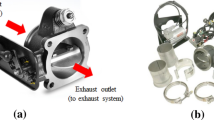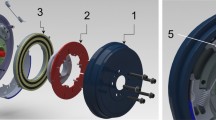Abstract
The disc or drum brakes are used in a conventional braking system. Any vehicle's braking system is required to slow or stop its movement. Brake systems in automobiles were used in response to high comfort and safety standards under various operating conditions. A magnetic braking prototype model is developed and examined in this study to improve the braking system in automobiles. The experimental results observed that increasing the electric current generates an electromagnet which creates drag force and causes the vehicle speed to be slow down. The aim of the electromagnetic braking system is to reduce brake failure and prevent accidents on the road. It also minimizes braking system maintenance. This system has the benefit of being able to be installed in any vehicle with simple transmission and electrical system adjustments.
Access provided by Autonomous University of Puebla. Download conference paper PDF
Similar content being viewed by others
Keywords
1 Introduction
Friction is the most common technique of converting kinetic energy into heat in brakes, however, other methods may be used. The most common issue with conventional braking systems is that it generates heat and causes wear and tear. In an electromagnetic braking system, the braking is accomplished through frictionless concept, hence no heat is produced.
The electromagnetic brake is a driving system that uses magnetic flux to stop the vehicle. Electrical energy is used to create a magnetic field to produce eddy currents in electromagnetic brakes. These brakes depend on a continuous flow of electrical energy to function and any interruption in that supply may fail the system. The electromagnetic braking system minimizes braking distance when compared to a regular braking system.
The brake is actuated by magnetic force in an electromagnetic braking system. The electromagnet is coupled to a shaft via a disc that is fixed on the frame. When electricity is provided to the coil, the current running through it generates a magnetic field across the armature, which pulls the armature to the coil. As a result, the system generates a torque, and the vehicle finally comes to rest. Permanent magnets do not require any sort of energy source and may operate in a wide range of environments [1].
1.1 Literature Survey
Several literatures have been found in the topic of electromagnetic braking systems. According to a recent study, the magnetic braking is most reliable braking mechanism compare with other type of braking technology.
The magnetic braking effect is mainly concerned by the amount of eddy currents generated in the revolving disc positioned among the magnets in the magnetic braking system. Researchers provided the relationship for the electromagnets and the revolving disc and the generation of eddy currents [2].
An experiment involving the diameter, the radius, and the thickness of the disc, still supports variation in their values due to their relationship. It determines the basic construction of magnetic brakes by performing a straightforward experimentation with a bronze strip stretched between two magnetic poles [3].
Most of earlier studies focused on understanding the electromagnetic fields process and creating methods to determine the magnetic braking force on rotating discs. In view of an engineer, it is required to design of braking system configuration with real-world applications, the braking force controlled to achieve the design goals, and the braking structure stabilized while it is in use.
2 Mathematical Model
It uses sophisticated electromagnetic and thermal phenomena despite being a relatively simple mechanism. Therefore, empirical evidence is particularly important in theory of computation.
In the literature on eddy current brakes, there are three models discussed [4,5,6]. In Smythe’s method [4], the rotating component is treated as a disc with a finite radius, and a reflection approach is used to obtain a closed-form solution that is tailored to the geometry of the issue. The first step is to figure out how much induction of magnetic (B) generated by right-circular cylinders that induce eddy currents in a disc.
After computing the function, which indicates the current flowing from a point to the edge of the rotating disc any cross-sectional region, it is possible to calculate the torque by integrating the radial component of current, the electromagnetic induction, and the arm lever, then integrating across the surface area of the pole piece. Due to the demagnetizing effect, the flow of eddy current is short-circuited through the permeable pole parts of the electromagnet, consequently the overall flux would be.
where \(\phi_{0}\) is magnetic flux piercing through the disc at rest and \(\frac{{\beta^{2} \gamma^{2} \omega^{2} \phi }}{R}\) is demagnetizing magnetic flux acquired through dividing the electromagnet reluctance by the demagnetizing magnetomotive force.
The braking torque’s integration yields the following result:
where
- T:
-
torque of the brake
- ω:
-
angular velocity
- γ:
-
10−9/ρ
- ρ:
-
volume resistance of the disc
- Φ0:
-
flux penetrating the disc at rest
- D:
-
constant coefficient dependent on the positioning of poles
- R:
-
electromagnet reluctance
- β:
-
constant coefficient.
In contrast to experimental curve, this model works effectively on low speeds while decreases too quickly on high speeds. According to asymptotic behaviour, the torque falls off in the high-speed area more quickly than ω−1 in contrast to experimental results.
Smythe noted that all these performances might be caused by additional factors, so that the level of magnet iron saturation which will conflict with the expected relationship between magnetomotive force and flux (ϕ) and may adjust Eqs. (1) and (2).
In contrast to Smythe's technique, Schieber modified a common method of approach for a rotating system [5]. The following is the result at low speed only:
where
- σ:
-
electrical conductivity of rotating disc
- δ:
-
thickness of rotating disc sheet
- ω:
-
angular velocity
- π:
-
coefficient constant
- r:
-
radius of electromagnet
- m:
-
distance between the pole face centre and the disc axis
- a:
-
radius of the disc
- Bz:
-
Magnetic flux density for z component, z-axis is electromagnetic pole centre path.
The formulation of equation is utilized in low-speed applications. At low speeds, Schieber's calculation is quite similar to Smythe’s, and the concept applies to both rotating disc and linearly moving strip. The high-speed region is not investigated by Schieber.
According to inventions of Schieber and Smythe, Wouterse worked to come up with an effective solution for both the high-speed and low-speed regions [6]. The following expression is proposed by Wouterse for low speed:
where
- Fe:
-
braking force
- v:
-
speed.
The further variables are evaluation-based constraints that can be calculated using different eddy current brake types. In low-speed region, the formula fully concurs with Smythe’s conclusion. Three important aspects emerged from Wouterse's investigation into the air gap of magnetic field at various speeds:
-
(a)
The field minimally differs from the zero-speed field at extremely low speeds.
-
(b)
At the normal speed at which the maximum force is applied, the induction is significantly smaller than B0.
-
(c)
The magnetic flux density began to fall even more at higher speeds.
In response to the above study, Wouterse proposed the following solution for the high-speed province:
where
- ρ:
-
disc material specific resistance
- ξ:
-
the ratio of zone region width to air gap in the distribution of asymptotic current near poles
- D:
-
diameter of soft iron pole’s
- c:
-
total resistance of the disc contour to the disc under-pole contour section resistance
- \(v\):
-
the rotating disc’s tangential speed, considered at the pole’s centre
- B0:
-
air gap induction
- vk:
-
critical speed
- x:
-
air space between the pole surfaces which includes disc thickness or a coordinate that is perpendicular to the air space
- d:
-
disc thickness
- R:
-
distance between the disc’s centre and the pole’s centre.
3 Design of Electromagnetic Braking System
Figure 1 illustrates the proposed design of an electromagnetic braking system. The system uses current via a battery or an AC source. The braking pads are activated with help of an electromagnet through power source in order to stop the vehicle. Figure 2 represents electromagnetic braking system block diagram.
4 Experimental Setup
In this experimentation, the electromagnet braking system was developed and tested for braking as illustrated in Fig. 3. The motor is attached to the wheel on one side by a shaft, and an electromagnetic plate is attached to other side of the wheel. The iron core of the electromagnetic disc is permanently fastened over the drum.
The experimental reading is taken as the disc's rotational speed with the motor and the stopping time when the electromagnet is operating, and the motor power source is cut off. The experimental results are illustrated in Table.1. Figure 4 shows the performance of system during experimental work.
The motor is rotated the wheel. The speed controller allows for the variation of speed by reducing or increasing the motor's speed and altering the rate at which the wheels rotate. This speed is controlled by varying the current provided to the motor, which is done via a speed control switch. The load placed on the motor determines its speed; the motor runs at a low speed when there is a heavy load, and the motor runs at a high speed when the load is low. Rotation of the wheel is accomplished by the motor, which is connected to it through a shaft. The shaft connects to the wheel to the motor, which turns the wheel. The wheel rotation is tracked by the speed sensor.
5 Conclusion
In comparison with conventional braking systems, the electromagnetic braking technology is more efficient. When an emergency brake is applied to a conventional braking system, it results in a lot of slipping and a lot of braking distance. When an emergency brake is used, the electromagnetic system is designed to reduce braking distance and slippage. Finally, the magnetic braking system is totally controlled by electricity, which allows the operation to be completed rapidly.
References
Simeu E, Georges D (1996) Modeling and control of an eddy current brake. Contr Eng Pract 4:19–26
Hughes SB (2000) Magnetic braking: finding the effective length over which the eddy currents form. Physics Department, The College of Wooster, Wooster, Ohio
Wiederick HD, Gauthier N, Campbell DA, Rochon P (1987) Magnetic braking: simple theory and experiment. Am J Phys 55:500–503
Smythe WR (1942) On Eddy currents in a rotating disk. IEEE Electr Eng 61:681–684
Schieber D (1974) Braking torque on rotating sheet in stationary magnetic field. IEE Proc 121:117–122
Wouterse JH (1991) Critical torque and speed of eddy current brake with widely separated soft iron poles. IEEE Proc 138:153–158
Author information
Authors and Affiliations
Corresponding author
Editor information
Editors and Affiliations
Rights and permissions
Copyright information
© 2023 The Author(s), under exclusive license to Springer Nature Singapore Pte Ltd.
About this paper
Cite this paper
Yedukondalu, G., Srinath, A., Vishnubhotla, S.D., Lohith, K.A., Raviteja, D.S. (2023). Design and Development of Electromagnetic Braking System in Automobiles. In: Vasudevan, H., Kottur, V.K.N., Raina, A.A. (eds) Proceedings of International Conference on Intelligent Manufacturing and Automation. Lecture Notes in Mechanical Engineering. Springer, Singapore. https://doi.org/10.1007/978-981-19-7971-2_56
Download citation
DOI: https://doi.org/10.1007/978-981-19-7971-2_56
Published:
Publisher Name: Springer, Singapore
Print ISBN: 978-981-19-7970-5
Online ISBN: 978-981-19-7971-2
eBook Packages: EngineeringEngineering (R0)








